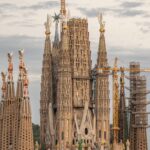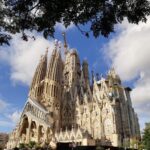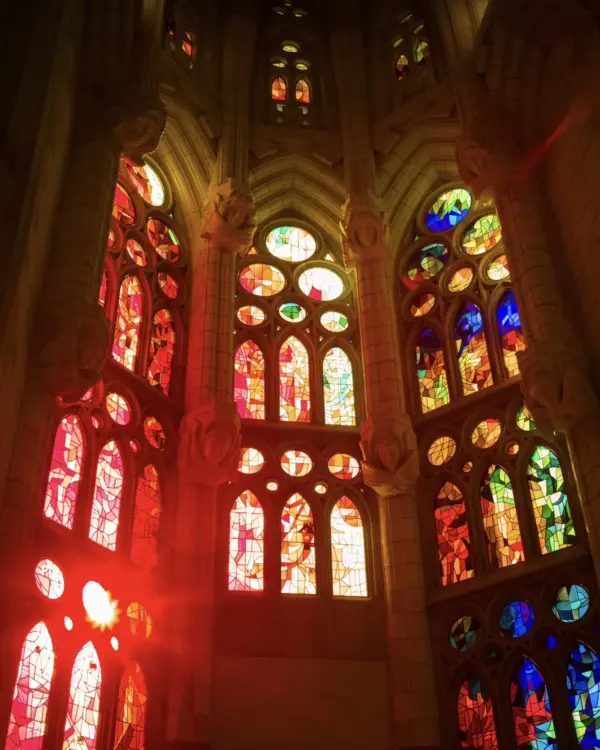
The Sagrada Familia in Barcelona is not only a masterpiece of architecture but also a canvas of vibrant artistry, particularly in its stunning stained glass windows. Each pane narrates a story through its intricate designs and colors, transforming sunlight into a breathtaking symphony of light within the basilica's interior.
In this exploration, we will delve into the significance and craftsmanship behind these remarkable windows. Join us in Unveiling the Beauty: Exploring the Stained Glass Windows of Sagrada Familia, Barcelona, where we will uncover the hidden meanings and artistic techniques that make this iconic structure a true marvel of modernism.
The Symbolism Behind Sagrada Familia's Stunning Stained Glass Windows
The stained glass windows of the Sagrada Familia are not merely decorative elements; they serve as profound symbols that encapsulate the essence of faith and spirituality. Each color and design reflects specific themes, contributing to a deeper **narrative** within the sacred space. The use of vibrant hues is intentional, representing various aspects of the divine, such as hope, love, and redemption.
One of the most striking features of these windows is their ability to evoke emotional responses through color symbolism. For example, the use of blue often signifies **heavenly peace**, while warm reds and oranges may represent the **passion** of Christ. These colors work together to create a cohesive storytelling experience as the light filters through, transforming the interior into a **meditative sanctuary**.
Furthermore, the intricate designs draw inspiration from nature and religious iconography. Each window tells a story and connects worshippers to biblical narratives, reflecting the journey of the human soul. Some key themes depicted in the windows include:
- The Creation - Illustrating the beauty of the world and God's hand in its making.
- The Life of Christ - Capturing pivotal moments from the Gospel.
- The Virgin Mary - Representing maternal love and compassion.
In summary, the stained glass windows of the Sagrada Familia serve as a testament to Gaudí's vision and devotion. They are masterfully crafted to engage viewers and evoke contemplation, reinforcing the basilica's role as a focal point of **spiritual enlightenment**. Through their symbolism and artistry, they invite all who enter to reflect on their own faith journeys amidst the breathtaking beauty.
A Guide to the Color Palette in Sagrada Familia's Stained Glass
The color palette of the stained glass windows in Sagrada Familia is a stunning blend of hues that not only captivates the eye but also enriches the spiritual experience within the basilica. The windows use a carefully selected array of colors, each chosen for its ability to convey specific emotions and messages. This deliberate color choice transforms sunlight into a magnificent display of light and shadow, creating an ethereal atmosphere that enhances the sense of divinity.
The windows predominantly feature a spectrum that ranges from warm reds and oranges, representing the earthly and passionate aspects of faith, to cool blues and greens, which embody tranquility and spiritual peace. This harmonious blend of colors allows worshippers to experience a profound connection to the spiritual themes inherent in the basilica's design. The interplay of light and color invites contemplation and reflection, deepening the overall experience.
Some of the most notable colors and their meanings in the stained glass windows include:
- Red: Symbolizes love, sacrifice, and the passion of Christ.
- Blue: Represents peace, tranquility, and the divine.
- Green: Reflects nature, growth, and renewal.
- Yellow: Signifies joy, light, and hope.
In essence, the color palette of Sagrada Familia's stained glass windows is not just an aesthetic choice, but a vital element of the overall design that communicates spiritual truths. As visitors wander through the basilica, they are enveloped in a kaleidoscope of color that not only dazzles the senses but also invites deeper reflection on the themes of faith and humanity.
How the Sunlight Transforms Sagrada Familia's Glass Art
The interplay between sunlight and the stained glass windows of the Sagrada Familia creates a mesmerizing display that transforms the interior atmosphere throughout the day. As the sun moves across the sky, it casts shifting patterns of color and light, turning the basilica into a dynamic visual experience. This phenomenon highlights the artistry behind the glass, revealing its intricate details that might go unnoticed in shadow.
Sunlight penetrates the windows, illuminating the rich colors and intricate designs, which serve to enhance the spiritual ambiance. The effect is particularly striking during certain times of the day, when the light filters through the glass at optimal angles, creating ethereal flashes of color and shadow. The result is a breathtaking scene that invites visitors to pause and reflect on their surroundings.
Key moments when sunlight enhances the stained glass experience include:
- Morning Light: Soft, warm hues fill the space, symbolizing hope and renewal.
- Noon Radiance: Bright, vibrant colors dominate, creating a lively and uplifting atmosphere.
- Evening Glow: Rich, warm tones bathe the interior, evoking a sense of peace and introspection.
This transformation underscores the importance of light in Gaudí's design, where every element is intentional and contributes to a larger narrative. The changing colors and patterns are not only visually stunning but also deepen the spiritual experience, inviting worshippers and visitors alike to explore their own reflections and connections to the divine.
Exploring the Artistic Techniques of Sagrada Familia's Stained Glass Design
The artistic techniques employed in the stained glass windows of Sagrada Familia showcase a remarkable blend of tradition and innovation. Gaudí's vision was to create windows that not only complemented the architectural form but also enhanced the spiritual experience of the space. The use of variegated glass, with its unique texture and color variations, allows each piece to interact with light in distinct ways, transforming the atmosphere with every passing moment.
One fascinating technique is the incorporation of gradient colors within individual panes. This method enables a smooth transition between shades, further enriching the visual narrative. The windows utilize a combination of thick and thin glass, creating a dynamic depth that enhances the play of light. This thoughtful layering is pivotal in conveying the intended symbolism and elevating the emotional impact of the scenes depicted.
Additionally, the windows often feature intricate patterns and motifs inspired by natural forms, such as flora and fauna. This connection to nature is not merely decorative; it serves as a reminder of the divine presence within the natural world. Key artistic elements include:
- Floral Designs: Symbolizing growth and renewal.
- Geometric Patterns: Reflecting harmony and order in creation.
- Religious Icons: Reinforcing the narrative of faith throughout the basilica.
In conclusion, the stained glass windows of Sagrada Familia are a testament to Gaudí's mastery of artistic techniques, showcasing his ability to intertwine light, color, and meaning. Each window serves as a unique expression of spiritual themes, inviting visitors to engage with the profound beauty that surrounds them. As the light dances through these masterpieces, it not only highlights their artistic intricacies but also invites reflection on the deeper messages woven into the fabric of this iconic structure.
The Historical Context of Stained Glass in the Sagrada Familia Architecture
The historical context of stained glass in the Sagrada Familia reveals a significant evolution tied closely to the life and vision of architect Antoni Gaudí. Stained glass artistry flourished during the Gothic Revival in the 19th century, a period that emphasized spiritual expression through architecture. Gaudí embraced this movement, infusing his designs with vibrant colors and symbolic narratives that enhance the spiritual ambiance of the basilica, making it a pivotal element of his modernist approach.
Moreover, the use of stained glass in the Sagrada Familia reflects the broader cultural and artistic currents of Catalonia during Gaudí's time. The region experienced a resurgence of interest in traditional crafts and a desire to incorporate local identity into architectural designs. This cultural backdrop allowed Gaudí to experiment with innovative techniques and materials, resulting in stained glass that blends traditional craftsmanship with modern artistic interpretations.
As construction of the Sagrada Familia progressed, Gaudí's vision for the stained glass windows evolved, showcasing a unique combination of light and color that tells a story. Each window is meticulously designed to create an emotional response, allowing worshippers to connect with the themes of faith and spirituality. Key historical influences include:
- The Gothic Tradition - Providing foundational techniques in stained glass artistry.
- Symbolism of Color - Transforming light into a narrative tool that conveys spiritual messages.
- Modernist Innovations - Blending traditional designs with contemporary techniques to create unique visual experiences.
In conclusion, the stained glass windows of the Sagrada Familia are not only a testament to Gaudí's artistic genius but also a reflection of the historical and cultural contexts of his time. By examining the evolution of stained glass within this iconic architecture, one gains a deeper appreciation for how these windows enrich the spiritual experience of the basilica, inviting visitors to engage with the divine through the transformative power of light and color.
Experiencing the Spiritual Impact of Sagrada Familia's Colorful Windows
Experiencing the spiritual impact of Sagrada Familia's colorful windows is akin to stepping into a living canvas where light becomes the medium of divine expression. As sunlight streams through the stained glass, it envelops visitors in a warm embrace of colors that resonate with profound emotional and spiritual themes. This transformative effect invites contemplation and reflection, allowing individuals to connect deeply with their faith amidst the breathtaking artistry.
The windows' vibrant hues are more than just aesthetic choices; they reflect a spiritual narrative that speaks to the human experience. Each color infuses the space with meaning, where:
- Amber and Gold: Evoke feelings of joy and divine presence.
- Turquoise: Represents serenity and spiritual clarity.
- Deep Violet: Signifies mystery and devotion.
As visitors move through the basilica, they witness a dance of light that changes throughout the day, enhancing the spiritual ambiance in ways that are both uplifting and introspective. This fluidity of color serves as a reminder of the ever-present nature of the divine, illuminating the path of faith and personal growth.
Ultimately, the stained glass windows of the Sagrada Familia are designed not just to beautify the sacred space but to create a meditative atmosphere that resonates with all who enter. The interplay of light and color encourages a deeper understanding of the spiritual journey, prompting visitors to explore their own beliefs while immersed in the rich tapestry of artistic expression that Gaudí envisioned.
 The Sagrada Familia in Barcelona: When Will it Be Finished?
The Sagrada Familia in Barcelona: When Will it Be Finished? Sagrada Familia Barcelona: What Is It and Why You Must Visit
Sagrada Familia Barcelona: What Is It and Why You Must VisitIf you want to know other articles similar to Unveiling the Beauty: Exploring the Stained Glass Windows of Sagrada Familia, Barcelona you can visit the category WHERE YOU CAN GO.
Leave a Reply










Read more!